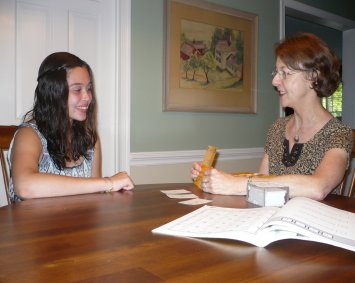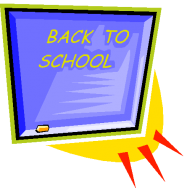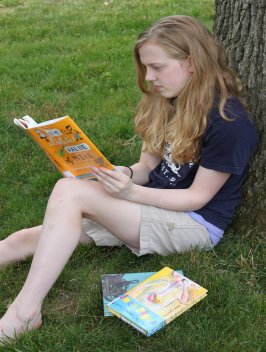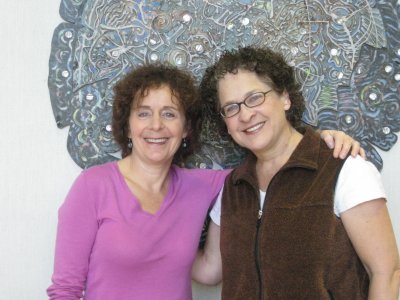|
If you could learn or teach with the method that suits you best, what would it be? Listening to music while working? Lying on the classroom floor to read? Painting a picture instead of writing a report?
Every student is unique and a little variety goes a long way toward meeting the needs of each one.
In this issue we offer resources for catering to students' Multiple Intellingences and particular Learning Styles. | |
|
INTELLIGENCE BY ALL MEANS |
|
by Linda Philips
Multiple Intelligence, the learning theory put forth by Howard Gardner in his 1983 book Frames of Mind, means business as usual to me.

Linda teaching an oral lesson during an Orton-Gillingham session.
I teach at a school for learning disabled students where we employ the VAK learning style daily. Visual, auditory, kinesthetic (VAK) learning has been around since the 1920’s.
The premise with early VAK specialists was simple. Children who could not learn words and letters by the conventional, visual methods might learn more easily by tactile methods, such as tracing letter shapes with their fingers.
Today, a typical Orton-Gillingham lesson (named for two of the educational pioneers) incorporates a multi-sensory approach that includes visual, auditory and kinesthetic drills. Such drills might include visual recognition of flash cards; tracing letters on mesh, felt, or even shaving cream; or written interpretation of oral cues.
Hopefully, a school that embraces the multiple intelligence theory will provide students with opportunities to use the learning styles best suited to their needs. At our school you might witness any of the following:
- mixed ability level reading students collaborating on writing and performing a script based on a novel;
- science students working in cooperative groups to solve mechanical problems in a timely manner;
- computer students designing and creating videos that they must present to the school.
I am thrilled to acknowledge the eight intelligences Gardner and other proponents of multiple intelligence support: word, math, picture, music, body, people, nature, and self. Trying to incorporate as many of these as possible in my lessons keeps me on my toes, and provides an enhanced opportunity for learning for a diverse population of students.
Visit Linda's blog, Mind-Full for more insights into how a teacher and writer tries to keep a mind full of good mental health, good writing, and good teaching practices. | |
|
E-Tools for Differentiated Instruction |
|
Carol asked Steve Johnson, author of Digital Tools for Teaching, "How can E-tools be used to enhance learning for different types of learners?"

Here is Steve's answer:
The first way technology helps students is by providing a way to identify their areas of relative strength and weakness. My favorite multiple intelligence quiz is provided by Edutopia. This quiz gives students a percentage for each of their intelligences. After taking the quiz, students can work with their teacher to determine areas of strength and weakness.
Digital tools also offer exciting avenues for students to express their intelligences in ways not matched by traditional means. Here are some great, completely free options that students can use.
Spatial: Glogster creates online multimedia posters.
Bodily-Kinesthetic: Link American Sign Language to vocabulary.
Logical-Mathematical: Timetoast Create interactive timelines.
Linguistic: Wordle Create word clouds that analyze text.
Interpersonal: ePals Connect and collaborate with students across the globe.
Intrapersonal: KidBlog Student-friendly, safe blogging service.
Musical: Beatlab. Create and record music tracks.
Naturalistic: Spore Creature Creator, Trial Edition. Easily create creatures of all shapes and sizes.
Providing multiple means of collaborating, creating, and publishing online will give every student the ability to express themselves in fresh, authentic ways. Introduce your students to these digital tools and they'll surprise you with their creativity and multiple intelligences at work!
****************
Steve has more information and resources on his website and blog.
For an overview of Digital Tools for Teaching, read Carol's blog. In a nutshell, Steve makes technology accessible to every teacher--even those who are techno-phobic! | |
|
NC ILLUSTRATOR WITH NATURALIST INTELLIGENCE |
|
|
For Your Elementary Classroom |
|

During the first week of school, introduce your classroom rules via Multiple Intelligences OR Learning Styles. Set up stations with your rules at each one. Rotate students through the stations.
1. Linguistic intelligence - Display a list of the class rules. Ask students to copy the rules onto a whiteboard or read them into a tape recorder.
2. Logic/Mathematical - Cut a poster of the class rules into a puzzle for students to assemble, then read.
3. Bodily-Kinesthetic - Have students read the class rules while moving, (rolling a ball across a table, tossing a bean bag to a friend, doing jumping jacks, etc.
4. Visual - Spatial - Create a "class rules" poster with pictures instead of words. Find an image or take a photo that demonstrates each guideline. OR ask students to illustrate one of the rules.
5. Musical - Create a musical or rap version of your rules. Provide a tape recorder for students to sing along. OR let them set the guidelines to music of their own.
6. Interpersonal - Ask a group of children to act out what could go wrong if they disobey one of the rules.
7. Intrapersonal - Ask students to choose one of the rules as their favorite and to copy it onto a card with their name.
8. Naturalistic - Use animals and their characteristics to illustrate the rules. Images of giraffes standing quietly in the lunch line. Elephants with ears spread wide for listening when others are speakings, Octopus lending helping hands, etc.
If you'd like to keep things simpler, introduce the rules through 3 stations for the 3 Learning Styles.
1. Visual Learning - Have each student illustrate one of the rules. Display the collection for all to enjoy.
2. Auditory Learning - Create a rap or clapping rhythm to use while going over the rules.
3. Kinesthetic Learning - Learn the rules to sign language.
Give students time to explore the stations. After they've finished, go over the class rules together. Ask students to reflect on which station was easiest and most appealing for them to use. Briefly explain multiple intelligences and Learning Styles and encourage students to continue thinking about what their styles are.
Keep the stations but change the content occasionally to coordinate with concepts you're learning. Note which students exhibit interest in which intelligence.
During the school year, if a student is struggling to learn a particular concept, consider letting him do his work in one of the stations that facilitates learning through his preferred style. | |
|
A TEEN'S TAKE ON THREE NOVELS |
|
by Anna Sattler
The Reinvention of Edison Thomas by Jacqueline Houtman displays an autistic boy who can retain random information, yet severely lacks necessary social skills. From the help of caring classmates he learns to help others through his knowledge and learns to respond to emotions. I found this book entertaining, with a lovable and endearing main character and a heartwarming theme.
In The Absolute Value of Mike by Kathryn Erskine, Mike, a young teenager, tries to please his father, who is a mathematical genius. However, math is Mike’s weak point. Trying to impress his father, Mike agrees to assist in an upcoming engineering project, but the project is different and more valuable than everyone expects. I enjoyed reading about these unusual but lovable Pennsylvanian characters who portrayed a different culture from my own suburban perspective.
Joey Pigza Swallowed the Key by Jack Gantos is a crazy and fast-paced story about a boy who randomly swallows keys and sticks his fingers into pencil sharpeners. Once his teachers finally realize that he has ADD, Joey slowly learns, with the help of his new teacher and medication, how to live a normal life and survive at school. This book moves with Joey's erratic thoughts and I was fascinated by this glimpse into an ADD kid's mind.

Anna Sattler is a sophomore at Plumstead Christian School in Pennsylvania. As a result of her five older siblings’ influence, she thoroughly enjoys reading, practicing her French horn, and playing field hockey. | |
|
Differing Intelligences Make For Great Teamwork |
|
by Joyce

Carol and Joyce
As Carol and I co-produce this newsletter we appreciate the fact that we have different intelligences! And because of our differences we find that we make a really good team.
- Carol is the non-fiction writer with several books and magazine articles on her resume.
- I specialize in historical fiction and have a few novels on mine.
- We're both overwhelmed most of the time but Carol thinks ahead, checking items off our "to do" list so that she can focus on what is in front of her.
- I work on the most pressing tasks of the moment and adjust my goals and deadlines to suit my whims.
- Carol obsesses over - er I mean focuses on - our subscriber list.
- I obsess over colors, font, and layout. (any weird formatting is strictly the work of the impish little brownies who hang out in the html box!) And we'll blame lousy colors on your monitor too. Okay?
Carol and I both think the other has the harder job and are glad not to be taking care of those details! | |
|
|
|
WINNERS OF OUR MAY GIVEWAY |
|
Jean Hall won Vanishing Point by Louise Hawes.
Linda Phillips won Outdoor Art by Irene Luxbacher.
Ann Dalton won Chasing Vermeer by Blue Balliett. | |
|
Send us an email and we'll enter your name to win one of these three giveaways.
Send us the email before Monday, July 10 when the contest ends. (Or better yet, enter right now!) | |
|
Howard Gardner's Multiple Intelligences |
|
1. Linguistic - word oriented people who like to read and write.
2. Logical-Mathematical - drawn to numbers, patterns, logic etc.
3. Bodily-Kinesthetic - benefit from moving while learning. Athletes or dancers
4. Spatial - think in pictures.
5. Musical - tune in to sounds arond them. Learn through songs, with background music, etc.
6. Interpersonal - good communicators, social, leaders
7. Intrapersonal - aware of their own feelings, self-motivated.
8. Naturalistic - drawn to nature and living things | |
|
You're Smarter Than You Think: A Kid's Guide to Multiple Intelligences |
|
|
1. Visual Learners process information well through seeing and reading.
2. Auditory Learners like to listen to explanations and learn through music and sound.
3. Kinesthetic learners prefer hands-on activities. | |
|
Train up a child in the way he should go (and in keeping with his individual gift or bent) and when he is old he will not depart from it. (Proverbs 22:6 Old Testament)
Children are like wet cement. Whatever falls on them makes an impression. (Dr. Haim Ginott)
The finest inheritance you can give to a child is to let it make its own way, completely on its own feet. (Isadora Duncan)
Free the child's potential and you will transform him into the world. (Maria Montessori)
Children in a family are like flowers in a bouquet. There is always one determined to face an opposite direction than the arranger desires. (Marcelene Cox) | |
|
Differentiating Instruction in the Regular Classroom |
|
|
We offer Writers-in-Residence programs and would be happy to customize workshops for your school and grade level. Here are some topics to choose from:
•Pump Up the Narrative!
•Jazz Up your Writing!
•Writing Memorable Memoirs
•Writing From the 5 Senses
•Writing Across the Curriculum: Using Short Fiction to Supplement Science & Social Studies
We also offer an in-depth workshop that is built around one specific social studies event of your choosing.
Contact us for more info. | |
|
We produce this newletter with the help of a lot of great writers, teachers, and friends. In this issue we appreciate contributions by Linda Phillips, Steve Johnson, Anne Runyon, and Anna Sattler.
A special thanks to Maupin House, Jacqueline Houtman, and Penguin Young Readers. They're responsible for this issue's generous giveaways. | |
|
In our next issue, we will explore "Novel Ideas for Learning." | |
|
Have you used some unusual tools to facilitate learning in your classroom? Send us your idea(s) and we will include your name in this issue's giveaway contest. If we use your idea, then we'll enter you in the next issue's giveaway contest also. | | |
